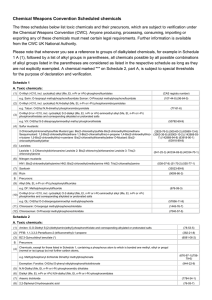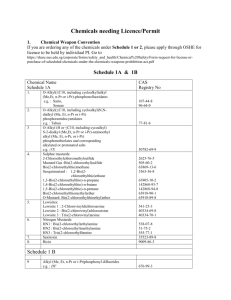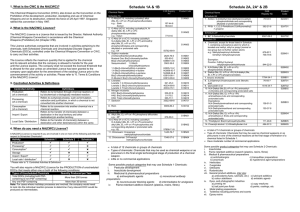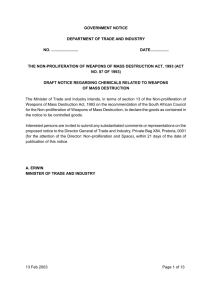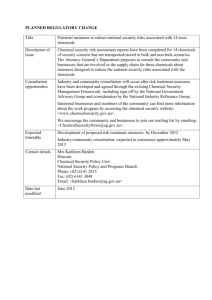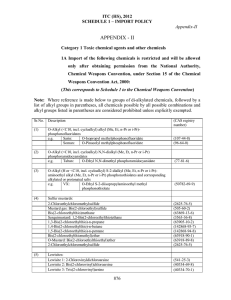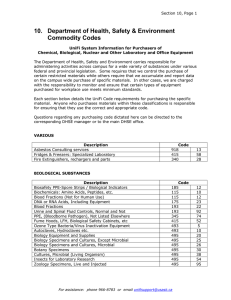Questionnaire on the Chemical Weapons Convention
advertisement
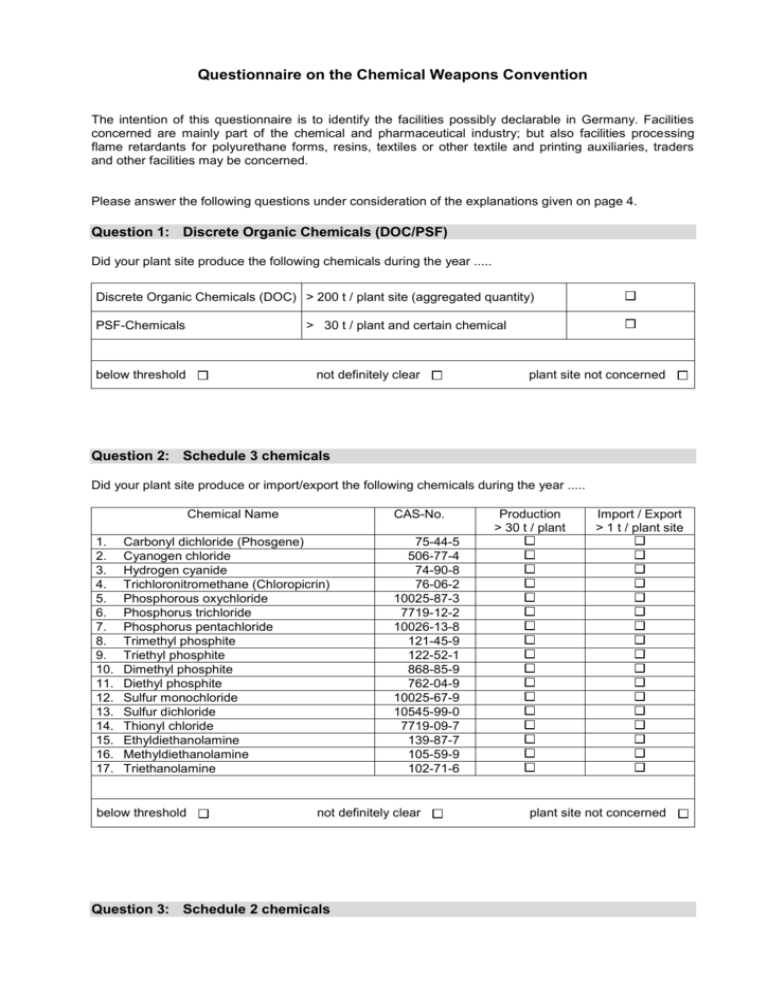
Questionnaire on the Chemical Weapons Convention The intention of this questionnaire is to identify the facilities possibly declarable in Germany. Facilities concerned are mainly part of the chemical and pharmaceutical industry; but also facilities processing flame retardants for polyurethane forms, resins, textiles or other textile and printing auxiliaries, traders and other facilities may be concerned. Please answer the following questions under consideration of the explanations given on page 4. Question 1: Discrete Organic Chemicals (DOC/PSF) Did your plant site produce the following chemicals during the year ..... Discrete Organic Chemicals (DOC) > 200 t / plant site (aggregated quantity) PSF-Chemicals > 30 t / plant and certain chemical below threshold not definitely clear plant site not concerned Question 2: Schedule 3 chemicals Did your plant site produce or import/export the following chemicals during the year ..... Chemical Name 1. 2. 3. 4. 5. 6. 7. 8. 9. 10. 11. 12. 13. 14. 15. 16. 17. CAS-No. Carbonyl dichloride (Phosgene) Cyanogen chloride Hydrogen cyanide Trichloronitromethane (Chloropicrin) Phosphorous oxychloride Phosphorus trichloride Phosphorus pentachloride Trimethyl phosphite Triethyl phosphite Dimethyl phosphite Diethyl phosphite Sulfur monochloride Sulfur dichloride Thionyl chloride Ethyldiethanolamine Methyldiethanolamine Triethanolamine below threshold Import / Export > 1 t / plant site 75-44-5 506-77-4 74-90-8 76-06-2 10025-87-3 7719-12-2 10026-13-8 121-45-9 122-52-1 868-85-9 762-04-9 10025-67-9 10545-99-0 7719-09-7 139-87-7 105-59-9 102-71-6 not definitely clear Question 3: Schedule 2 chemicals Production > 30 t / plant plant site not concerned Did your plant site produce, process, consume or import/export the following chemicals during the year .... Chemical Name CAS-No. 1. 0,0-Diethyl-S-[2-(diethylamino)-ethyl ]phosphorthiolate (Amiton) and corresponding alkylated or protonated salts 2. 1,1,3,3,3-Pentafluoro-2-(trifluoromethyl)-1propene (PFIB) 3. 3-Quinuclidinyl benzilate (BZ) Production, Processing, Consumption (per plant) 78-53-5 > 100 kg > 10 kg 382-21-8 > 100 kg > 10 kg > 1 kg > 100 g 6581-06-2 >1t: 4. Chemicals containing a phosphorus atom to which is bonded one methyl, ethyl or propyl (normal or iso) group but no further carbon atoms e.g. Methylphosphonyl dichloride Dimethyl methylphosphonate (DMMP) except for: O-Ethyl-S-phenyl ethylphosphonothiolothionate (Fonofos) and Chemicals of Schedule 1 5. N,N-Dialkyl (Me, Et, n-Pr oder i-Pr)phosphoramidic dihalides 6. Dialkyl (Me, Et, n-Pr oder i-Pr)-N,N-dialkyl(Me, Et, n-Pr oder i-Pr)-phosphoramidates 7. Arsenic trichloride 8. 2,2-Diphenyl-2-hydroxyacetic acid 9. Qhinuclidine-3-ol 10. N,N-Dialkyl (Me, Et, n-Pr or i-Pr) aminoethyl-2-chlorides and corresponding protonates salts 11.N,N-Dialkyl(Me, Et, n-Pr oder i-Pr)-amino ethane-2-ols and corresponding protonated salts exemptions: N,N-Dimethylamino ethanol and correspond. protonated salts N,N-Diethylamino ethanol and corresponding protonated salts 12.N,N-Dialkyl (Me, Et, n-Pr or i-Pr)aminoethane -2-thiols and corresponding protonated salts 13 Bis-(2-hydroxyethyl)-sulfide (Thiodiglykol) 14. Pinacolyl alcohol: 3,3-Dimethylbutane-2-ol below threshold > 100 kg: 676-97-1 756-79-6 944-22-9 7784-34-1 76-93-7 1619-34-7 108-01-0 100-37-8 111-48-8 464-07-3 not definitely clear Question 4: Schedule 1 chemicals Import / Export (per plant site) 3,3-Dimethylbutan- plant site not concerned Did your plant site handle the following chemicals during the year .... (Some of the below-mentiones chemicals like Saxitoxin, Ricin or Nitrogen mustards have a civilian use. Schedule 1 chemicals have to be declared also as e.g. by-products in the production of other chemicals ) Chemical Name 1. O-Alkyl ( C10 incl. cycloalkyl) alkyl (Me, Et, n-Pr oder i-Pr)phosphonofluoridates e.g. O-Isopropyl methylphosphonofluoridate (Sarin) O-Pinacolyl methylphosphonofluoridate (Soman) 2. O-Alkyl ( C10 incl. cycloalkyl)-N,N-dialkyl (Me, Et, n-Pr oder i-Pr)phosphoramidocyanidates e.g. O-Ethyl N,N-dimethyl phosphoramido cyanidate (Tabun) 3. O-Alkyl (H oder C10 incl. cycloalkyl)-S-2-dialkyl (Me, Et, n-Pr oder iPr)-aminoethyl alkyl (Me, Et, n-Pr oder i-Pr)-phosphonothiolates and corresponding alkylated or protonated salts e.g. O-Ethyl-S-2-diisopropyl-aminoethyl methyl phosphonothiolate (VX) 4. Sulfur mustards 2-Chloroethylchloromethylsulfide Bis(2-chloroethyl)-sulfide (mustard gas) Bis(2-chlorethylthio)-methane Sesquimustard: 1,2-Bis(2-chloroethylthio)ethane 1,3-Bis(2-chloroethylthio)-n-propane 1,4-Bis(2-chloroethylthio)-n-butane 1,5-Bis(2-chloroethylthio)-n-pentane Bis(2-chloroethylthiomethyl)ether Bis(2-chloroethylthioethyl)ether (O-Mustard) 5. Lewisites: 2-Chlorovinyldichloroarsine (Lewisite 1) Bis(2-chlorovinyl)-chloroarsine (Lewisite 2) Tris(2-chlorovinyl)-arsine (Lewisite 3) 6. Nitrogen mustards: Bis(2-chlorothyl)-ethylamine (HN1) Bis(2-chloroethyl)-methylamine (HN2) Tris(2-chloroethyl)-amine (HN3) 7. Saxitoxin 8. Ricin 9. Alkyl (Me, Et, n-Pr oder i-Pr)-phosphonyl-difluorides e.g. Methylphosphonyl difluoride (DF) 10. O-Alkyl(H oder C10 incl. cycloalkyl)-O-2-dialkyl(Me, Et, n-Pr oder i-Pr)aminoethyl alkyl (Me, Et, n-Pr oder i-Pr) phosphonites and corresponding alkylated and protonated salts e.g. O-Ethyl-O-2-diisopropylaminoethylmethylphosphonite (QL) 11. O-Isopropyl methyl phosphonochloridate (Chlorosarin) 12. O-Pinacolyl methylphosphonochloridate (Chlorosoman) not definitely clear Explanations: CAS-No. 107-44-8 96-64-0 77-81-6 50782-69-9 2625-76-5 505-60-2 63869-13-6 3563-36-8 63905-10-2 142868-93-7 142868-94-8 63918-90-1 63918-89-8 541-25-3 40334-69-8 40334-70-1 538-07-8 51-75-2 555-77-1 35523-89-8 9009-86-3 676-99-3 57856-11-8 1445-76-7 7040-57-5 plant site not concerned Chemicals in mixtures (concentration limits): Schedule 2 and 3 Chemicals are declarable if they are contained in a mixture in a concentration of > 30 weight percent. Quantity is the absolute amount of the chemical which may be available in a pure form or as a component of a mixture. If the chemical is contained in a mixture only the amount of that chemical contained shall be taken into consideration. CAS-No.: Registry number of the „Chemical Abstracts Service“ to identify a chemical. Indicate the CAS no. of a chemical if assigned. It helps to identify the systematic name, structural formula and empirical formula. "below threshold ": tick if an activity reffering to one of the above-mentioned chemicals applies, but falls below the thresholds "not definitely clear ": tick if you handle substances/mixtures but you cannot exclude that they contain one of the above-mentioned chemicals. "plant site not concerned ": tick if none of the chemicals applies. plant site: The local integration of one or more industrial plants, with any intermediate administrative levels, which are under one operational control, and which includes common infrastructure. plant: A relatively self-contained area, structure or building containing one or more industrial units with auxiliary and associated infrastructure. Discrete Organic Chemical (DOC): Any chemical not mentioned in Schedules 1, 2 or 3 belonging to the class of chemical compounds consisting of all compounds of carbon - except for its oxides, sulfides and metal carbonates, identifiable by chemical name, by structural formula, if known, and by Chemical Abstracts Service registry number, if assigned. Exemptions are Oligomeres, Polymeres, Chemicals containing only carbon and metal (Carbide). DOC are only covered in pure or technically pure form. PSF-Chemical (PSF): A discrete organic chemical containing the elements phosphorous, sulfur or fluorine. They constitute a subset of DOC, the exceptions mentioned apply analogously. Production: The formation of a chemical through chemical reaction. The definition includes the production of chemicals of Schedules 1, 2 or 3 by means of biochemical or biological systems. Processing: A physical process, such as formulation, extraction and purification, in which a chemical is not converted into another chemical. Processing also includes processes like adding one or several components leading to a changed concentration or changed composition of a mixture. The simple filling of chemicals shall not be considered to be processing. Consumption: The conversion of a chemical into another via chemical reaction. Handling of Schedule 1 Chemicals: tick if you produce, process, trade in, sell, consume or acquire Schedule 1 chemicals, transfer them to another person or otherwise exercise effective control over such chemicals or import, export or perform the transit of such chemicals
